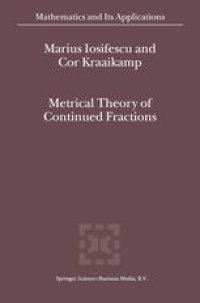
Ebook: Metrical Theory of Continued Fractions
- Tags: Probability Theory and Stochastic Processes, Number Theory, Operator Theory, Computational Mathematics and Numerical Analysis
- Series: Mathematics and Its Applications 547
- Year: 2002
- Publisher: Springer Netherlands
- Edition: 1
- Language: English
- pdf
This monograph is intended to be a complete treatment of the metrical the ory of the (regular) continued fraction expansion and related representations of real numbers. We have attempted to give the best possible results known so far, with proofs which are the simplest and most direct. The book has had a long gestation period because we first decided to write it in March 1994. This gave us the possibility of essentially improving the initial versions of many parts of it. Even if the two authors are different in style and approach, every effort has been made to hide the differences. Let 0 denote the set of irrationals in I = [0,1]. Define the (reg ular) continued fraction transformation T by T (w) = fractional part of n 1/w, w E O. Write T for the nth iterate of T, n E N = {O, 1, ... }, n 1 with TO = identity map. The positive integers an(w) = al(T - (W)), n E N+ = {1,2··· }, where al(w) = integer part of 1/w, w E 0, are called the (regular continued fraction) digits of w. Writing . for arbitrary indeterminates Xi, 1 :::; i :::; n, we have w = lim [al(w),··· , an(w)], w E 0, n--->oo thus explaining the name of T. The above equation will be also written as w = lim [al(w), a2(w),···], w E O.
The book is essentially based on recent work of the authors. In order to unify and generalize the results obtained so far, new concepts have been introduced, e.g., an infinite order chain representation of the continued fraction expansion of irrationals, the conditional measures associated with, and the extended random variables corresponding to that representation. Also, such procedures as singularization and insertion allow to obtain most of the continued fraction expansions related to the regular continued fraction expansion.
The authors present and prove with full details for the first time in book form, the most recent developments in solving the celebrated 1812 Gauss' problem which originated the metrical theory of continued fractions. At the same time, they study exhaustively the Perron-Frobenius operator, which is of basic importance in this theory, on various Banach spaces including that of functions of bounded variation on the unit interval.
The book is of interest to research workers and advanced Ph.D. students in probability theory, stochastic processes and number theory.
The book is essentially based on recent work of the authors. In order to unify and generalize the results obtained so far, new concepts have been introduced, e.g., an infinite order chain representation of the continued fraction expansion of irrationals, the conditional measures associated with, and the extended random variables corresponding to that representation. Also, such procedures as singularization and insertion allow to obtain most of the continued fraction expansions related to the regular continued fraction expansion.
The authors present and prove with full details for the first time in book form, the most recent developments in solving the celebrated 1812 Gauss' problem which originated the metrical theory of continued fractions. At the same time, they study exhaustively the Perron-Frobenius operator, which is of basic importance in this theory, on various Banach spaces including that of functions of bounded variation on the unit interval.
The book is of interest to research workers and advanced Ph.D. students in probability theory, stochastic processes and number theory.
Content:
Front Matter....Pages i-xix
Basic properties of the continued fraction expansion....Pages 1-51
Solving Gauss’ problem....Pages 53-163
Limit theorems....Pages 165-217
Ergodic theory of continued fractions....Pages 219-311
Back Matter....Pages 313-383
The book is essentially based on recent work of the authors. In order to unify and generalize the results obtained so far, new concepts have been introduced, e.g., an infinite order chain representation of the continued fraction expansion of irrationals, the conditional measures associated with, and the extended random variables corresponding to that representation. Also, such procedures as singularization and insertion allow to obtain most of the continued fraction expansions related to the regular continued fraction expansion.
The authors present and prove with full details for the first time in book form, the most recent developments in solving the celebrated 1812 Gauss' problem which originated the metrical theory of continued fractions. At the same time, they study exhaustively the Perron-Frobenius operator, which is of basic importance in this theory, on various Banach spaces including that of functions of bounded variation on the unit interval.
The book is of interest to research workers and advanced Ph.D. students in probability theory, stochastic processes and number theory.
Content:
Front Matter....Pages i-xix
Basic properties of the continued fraction expansion....Pages 1-51
Solving Gauss’ problem....Pages 53-163
Limit theorems....Pages 165-217
Ergodic theory of continued fractions....Pages 219-311
Back Matter....Pages 313-383
....